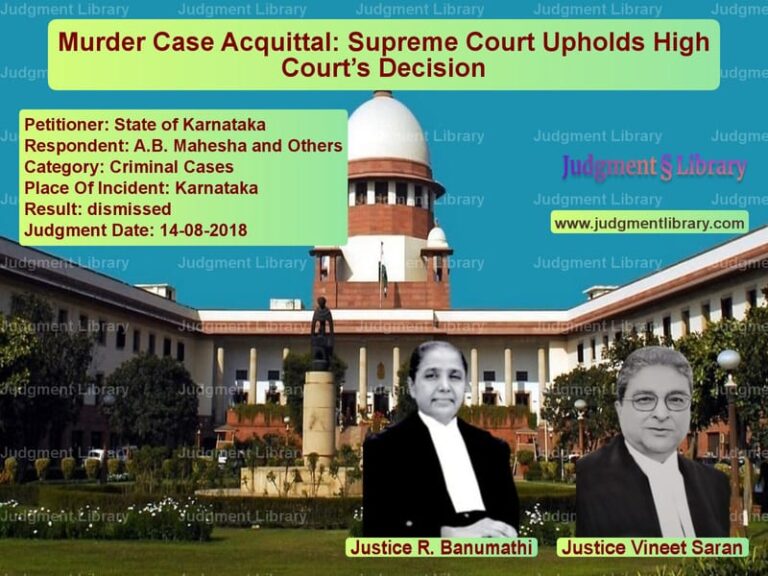Land Compensation Dispute: Supreme Court’s Verdict in A.V. Subramanian v. Union of India
Introduction
The case of A.V. Subramanian v. Union of India revolves around a land acquisition dispute where the appellant sought enhanced compensation for acquired land. The Supreme Court examined whether the appellant should receive the same compensation as other landowners whose lands were acquired under the same notification. The case highlights the principles of fairness in compensation and the importance of procedural justice in land acquisition matters.
Background of the Case
The appellant, A.V. Subramanian, challenged the decision of the High Court, which had reduced the compensation awarded by the Additional District Judge, Karaikal. The Union of India had appealed against the compensation granted by the Reference Court, and the High Court, in its ruling dated February 23, 2001, lowered the compensation. Dissatisfied with this decision, the appellant approached the Supreme Court.
The appellant initially filed a Special Leave Petition (SLP) in 2001, which was dismissed in limine on September 28, 2001. However, a subsequent judgment in a related case, Pattammal & Others v. Union of India (2005) 13 SCC 63, restored the Reference Court’s compensation. Since both cases involved the same notification, similar land, and the same purpose, the appellant filed a review petition before the High Court, seeking parity with the decision in Pattammal.
The High Court declined to review its judgment, prompting the appellant to file an appeal before the Supreme Court.
Legal Issues Raised
- Was the appellant entitled to the same enhanced compensation granted in the Pattammal case?
- Did the High Court err in refusing to review its order despite the Supreme Court’s decision in a similar case?
- Should procedural technicalities prevent fair compensation for landowners?
Arguments by the Appellant
- The appellant’s land was acquired under the same notification as in Pattammal, making it unfair for him to receive lower compensation.
- The Supreme Court’s judgment in Pattammal should be applied to his case since the land quality, notification, and purpose were identical.
- The High Court’s refusal to review the case led to inconsistent compensation among similarly situated landowners.
Arguments by the Respondents (Union of India)
- The appellant’s SLP had been dismissed in 2001, making the case final and barring further review.
- The appellant failed to challenge the High Court’s 2001 judgment through a proper review and curative process.
- Procedural rules prevent reopening a concluded case, even if a later ruling benefits other litigants.
Supreme Court’s Judgment
The Supreme Court ruled in favor of the appellant, setting aside the High Court’s order and granting him the same compensation awarded in Pattammal. The Court held:
“In a land acquisition case, the claimants have received different amounts by way of compensation for lands of the same nature, covered by the same notification, and acquired for the same purpose. All these technicalities should give way since they are procedural and can still be cured.”
The Court further stated:
“The appellant shall be entitled to the benefit of the judgment of this Court dated 08.11.2005 passed in Civil Appeal No. 1500 of 2004.”
Additionally, the Court clarified that any security obligations provided by the appellant to the High Court would be discharged upon receiving the revised compensation:
“In case the appellant has already received payments, needless to say, the obligation under the security offered before the High Court will stand discharged.”
Key Takeaways from the Judgment
- Equal Compensation for Similarly Placed Landowners: The Court upheld the principle that landowners with similar land acquired under the same notification must receive equal compensation.
- Procedural Technicalities Should Not Defeat Substantive Justice: The Court emphasized that procedural barriers should not prevent rightful compensation.
- Review Petitions Can Be Used to Rectify Unfair Disparities: The judgment reaffirmed that review petitions can be filed to correct inconsistencies arising from later Supreme Court rulings.
Implications of the Judgment
The ruling has far-reaching consequences for land acquisition cases:
- Standardization of Compensation: Government agencies must ensure uniform compensation for similar landowners.
- Importance of Review Mechanisms: Landowners affected by similar acquisitions should use review petitions if a later ruling creates disparities.
- Balancing Procedural and Substantive Justice: Courts must prioritize fairness over rigid procedural rules.
Conclusion
The Supreme Court’s ruling in A.V. Subramanian v. Union of India ensures that similarly placed landowners receive equal and fair compensation. By prioritizing substantive justice over procedural technicalities, the decision reinforces that compensation disparities in land acquisition cases must be addressed. This judgment serves as a crucial precedent for ensuring fairness in land acquisition disputes.
Don’t miss out on the full details! Download the complete judgment in PDF format below and gain valuable insights instantly!
Download Judgment: A.V. Subramanian vs Union of India and A Supreme Court of India Judgment Dated 10-01-2017.pdf
Direct Downlaod Judgment: Direct downlaod this Judgment
See all petitions in Damages and Compensation
See all petitions in Judgment by Kurian Joseph
See all petitions in Judgment by A M Khanwilkar
See all petitions in allowed
See all petitions in Modified
See all petitions in supreme court of India judgments January 2017
See all petitions in 2017 judgments
See all posts in Civil Cases Category
See all allowed petitions in Civil Cases Category
See all Dismissed petitions in Civil Cases Category
See all partially allowed petitions in Civil Cases Category







